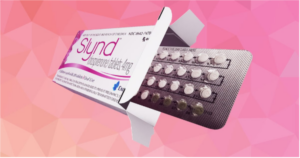
What’s the difference between progestin and estrogen in birth control pills?
When considering which oral contraceptive is right for you, two medical terms you might come across are progestin (a synthetic form of progesterone) and estrogen. These refer to two female sex hormones that are used in birth control products. Outside of their use in contraceptives, estrogen and progesterone are naturally produced in the female body and play key roles in regulating certain body functions in women throughout puberty, pregnancy, and menopause.
As two common hormones found in oral contraceptives, understanding the differences between combination pills and progestin-only pills can help you select one that fits your needs and lifestyle. Here, we will look at the major differences between progestin and estrogen as it relates to birth control, and why the pill is not “one size fits all.”
What you need to know about progestin
Progestin is a synthetic form of progesterone, which is a female hormone found in a woman’s body. As a naturally occurring hormone, progesterone is released from the ovaries to prepare the body for pregnancy. Progesterone also plays an important role during pregnancy. It contributes to maternal breast tissue growth while also preventing lactation, and prepares the body for labor by strengthening the wall muscles around the pelvic area.

What you need to know about estrogen
Like progesterone, estrogen is a sex hormone naturally produced in the body and is responsible for developing female sexual characteristics. For example, during puberty, estrogen contributes to the development of mammary ducts. During pregnancy, it supports functions that secrete breast milk. Estrogen is commonly found in birth control products, such as oral contraceptives and vaginal rings. It is also found in products that treat symptoms during menopause, such as hot flashes, vaginal dryness, and itching.
Combination birth control pills or progestin-only pills?
Combination Oral Contraceptives (COCs)
Combination birth control pills contain both estrogen and progestin. When used in birth control pills, progestin and estrogen thicken the mucus inside the cervix, making it harder for sperm to travel to the egg. They also work to thin the lining of the uterine wall so that if an egg is fertilized, it is more difficult to implant.
COCs are most effective when the pills are taken correctly according to the instructions. Most products on the market use a one-phase dosing cycle, or monophasic. In other words, tablets of one strength are taken for 21 days. A monophasic dosing cycle with 28 days will include seven inactive or placebo pills that are another color.
Other dosing schedules include biphasic (two-phase), triphasic (three-phase), and even quadriphasic (four-phase). The differences between these phases are the number of different colored pills formulated with different strengths. The benefit of a monophasic dosing cycle is that it’s much more straightforward and easier for patients to remember—they don’t have to remember what color pill corresponds to what formulation strength.
Chewables or soft gels have similar side effects as other traditional combined pills, including headaches, breakthrough bleeding, nausea, and weight gain. However, similar to other COC products, side effects may vary from person to person.
A benefit of chewable birth control is that it may be easier to swallow, especially for women who are experiencing nausea. While not chewable, soft gel capsules are more flexible and easier to swallow than traditional pills.
It is important to note that all combined oral contraceptives contain a boxed warning about the increased risk of heart and blood vessel problems as well as death from blood clots, heart attack, or stroke in females that smoke and are over 35, which increases with age and the number of cigarettes smoked and is therefore not recommended in this group.
Progestin Only Pills (POPs)
Progestin-only pills (POPs) only contain progestin (no estrogen). Progestin-only birth control pills also prevent pregnancy by thickening the mucus of the cervix and thinning the lining of the uterine wall.
For women who are breastfeeding and want to take oral contraception, doctors may recommend a progestin-only pill since estrogen may interfere with the production of breastmilk.
POPs may be more suitable for women who smoke and are over the age of 35 because they do not contain estrogen. Patients with a history of blood clots or high blood pressure should consider a POP which does not contain estrogen and you can avoid the estrogen side effects.
Slynd® is the first and only POP with a 24-hour missed pill window.a Most progestin-only pills must be taken at the same time each day within a 3 hour window.

When deciding between a combination oral contractive or a progestin-only pill, consult your healthcare provider to learn more about which option best suits you.
Click here to learn more about how Slynd® may fit your needs.
Do not take Slynd® if you:
- have kidney disease or kidney failure
- have reduced adrenal gland function (adrenal insufficiency)
- have or have had cervical cancer or any cancer that is sensitive to female hormones
- have liver disease, including liver tumors
- have unexplained vaginal bleeding
If any of these conditions happen while you are taking Slynd®, stop taking Slynd® right away and talk to your healthcare provider. Use non-hormonal contraception when you stop taking Slynd®.
Click here to read more Important Risk Information and Full Prescribing Information.
Slynd® is a trademark of Chemo Research, S.L.
©2023 Exeltis USA, Inc. All rights reserved.
WebMD Team. (2020). Progesterone: Overview, uses, side effects, precautions, interactions, dosing and reviews. WebMD.
Progesterone. You and Your Hormones. (2021, July).
Delgado, B. J., & Lopez-Ojeda, W. (2021). Estrogen. In StatPearls [Internet]. StatPearls Publishing.
Ginta, D. (2021, June 17). What are the symptoms of low estrogen in women and how are they treated? Healthline.
Gebel Berg E. (2015). The Chemistry of the Pill. ACS central science, 1(1), 5–7.
Mayo Clinic Team. (2020, December 17). Combination Birth Control Pills. Mayo Clinic.
Mayo Clinic Team. (2022, February 1). Estrogen and progestin oral contraceptives (oral route) proper use. Mayo Clinic.











